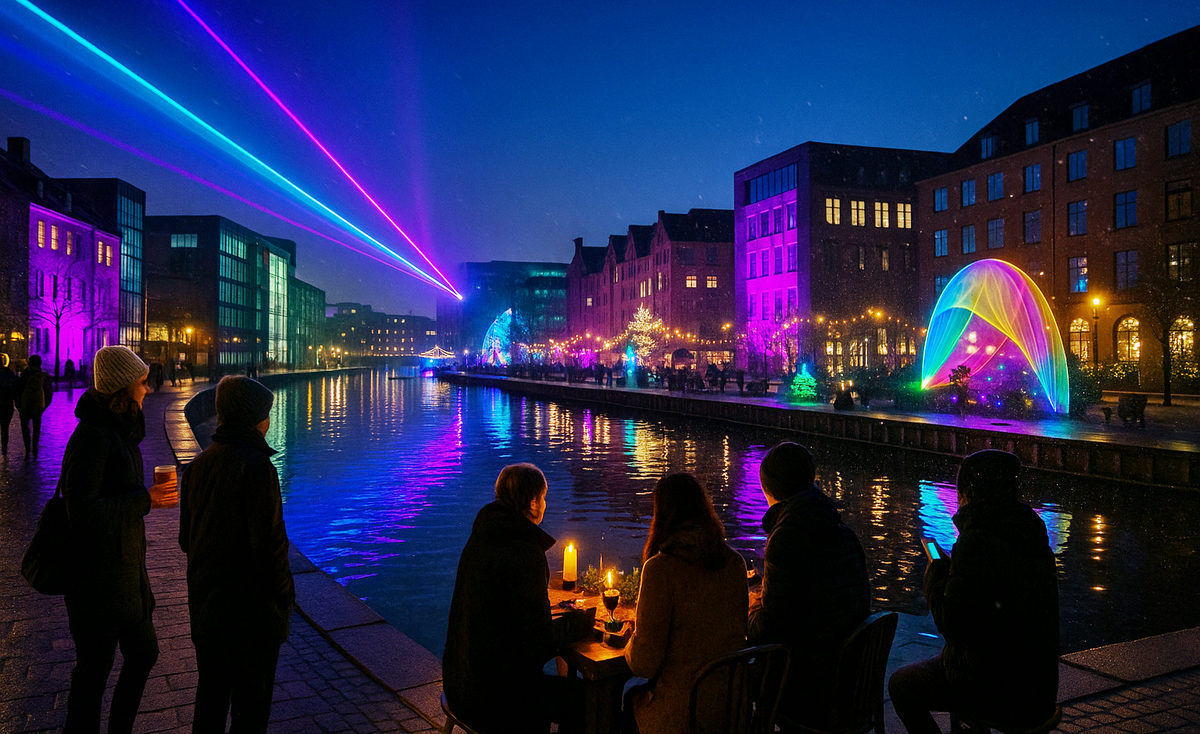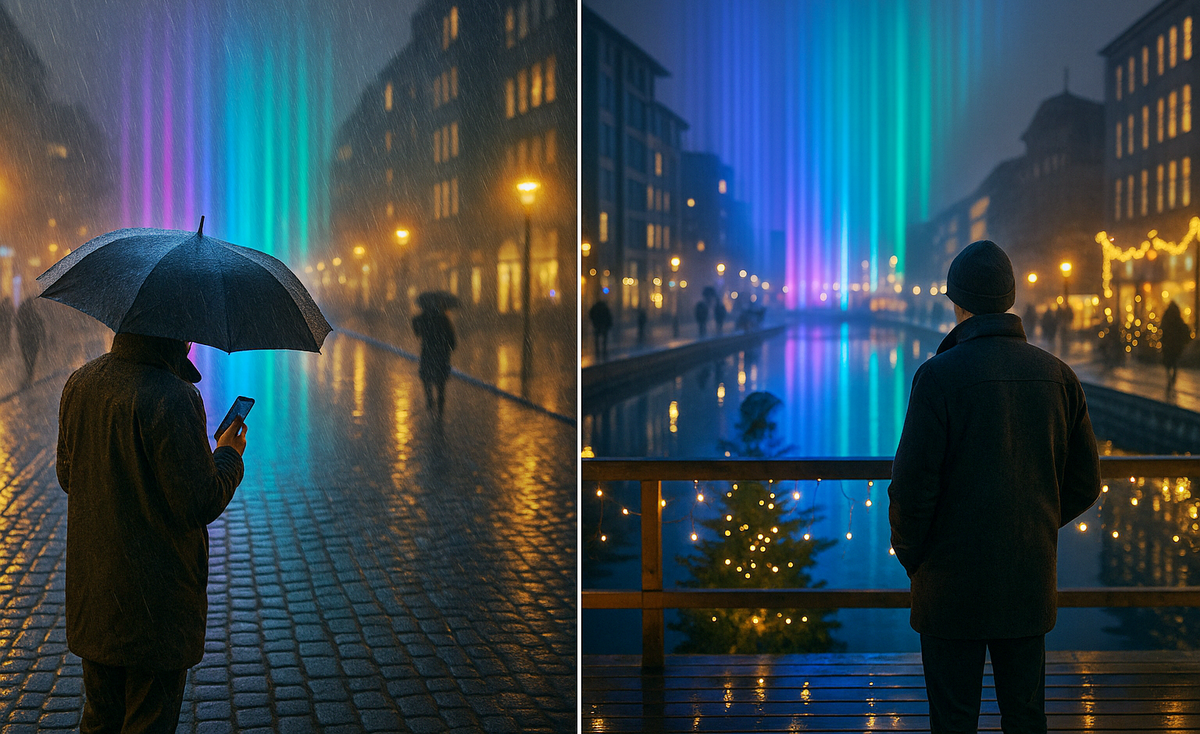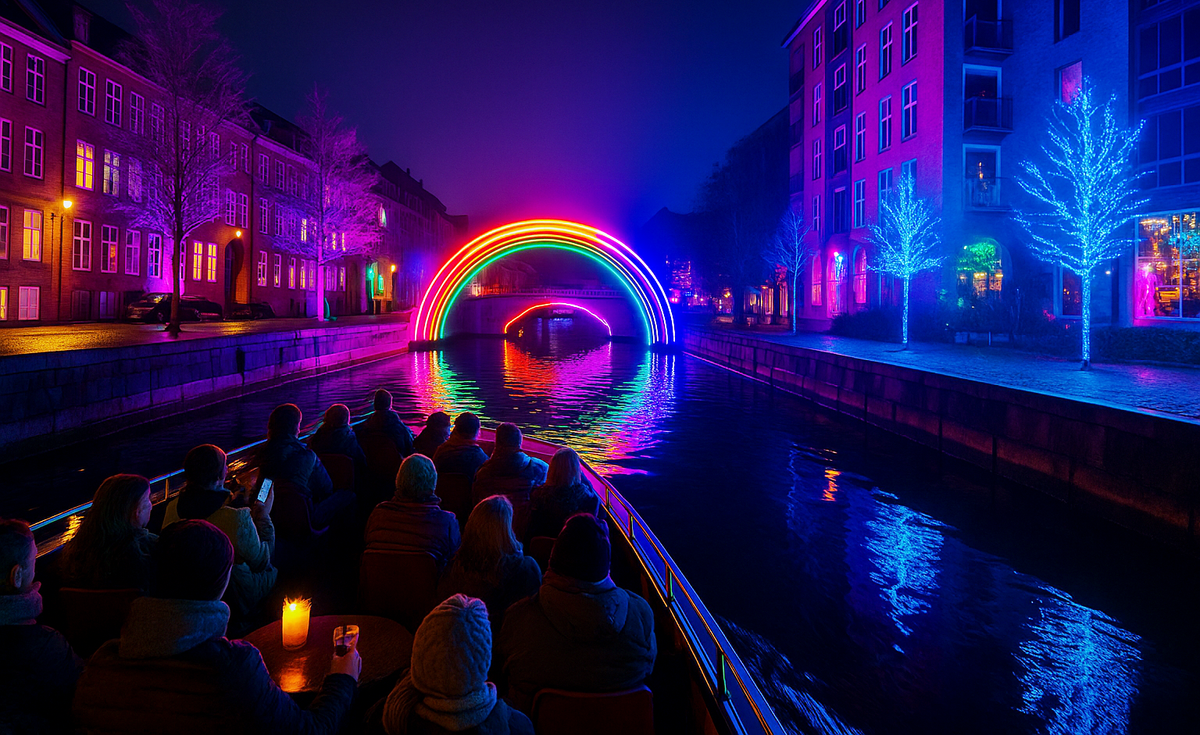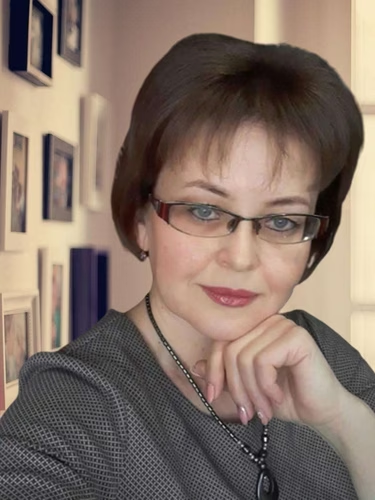🔦 February and the Copenhagen Light Festival: 2–3 evenings of light and hygge
February in Copenhagen sounds like a scenario of ‘cold, dark and not at all resort-like’ — until the Copenhagen Light Festival kicks off. This is an annual light art festival that usually lasts about three weeks in February and transforms the city into an open-air evening gallery.
Light installations are placed along the harbour, canals and in various areas from Nordhavn to Ørestad:
- light sculptures,
- illuminated facades and bridges,
- projections on buildings,
- interactive works that respond to movement or sound.
The best part is that the main programme is free: you simply walk around the city, following the festival map or your own curiosity. Some tours (boats, kayaks, guided tours) may be paid, but admission to the installations themselves is free.
In essence, CLF is a way to turn the ‘darkest and coldest’ month into ‘2-3 evenings of light and hygge’: you explore the city during the day and go out ‘into the lights’ in the evening, as if to a show.
🥶 February reality: weather, light and why choosing the right evening is important

🌡️ Temperature and sensations
February is one of the coldest months in Denmark:
- during the day it is usually around 0...+3 °C,
- at night the temperature can drop below zero,
- and humidity and wind add to the effect of ‘feeling colder than the numbers suggest’.
A typical situation: the thermometer reads +2 °C, but it feels like below freezing with a chilly wind. Therefore, the format of the festival is not a ‘light stroll in trainers’ but a serious winter outing.
✅ What to bring:
- layered clothing (thermal + sweater/fleece + windproof jacket),
- a warm hat and a thick scarf,
- good gloves,
- very warm and non-slip shoes: wet asphalt, possible snow and ice spare no one.
🌆 Daylight hours and the start of the route
In February, the days are still short, but already noticeably longer than in December:
- it starts to get dark closer to 5–6 p.m.,
- giving you a comfortable window to start the route at dusk and continue in complete darkness.
The optimal start time for a walk through the installations is 6:00–7:00 p.m.:
- it is already dark enough,
- by this time you will have had time to have dinner/drink coffee,
- and some cafes and bars are still open along the way for warm breaks.
🌦️ Why it is critical to choose a dry and quiet evening
Formally, you can see the Light Festival ‘any evening,’ but in reality, your experience depends greatly on the weather:
- wind + wet snow/rain quickly turn the beauty into ‘twenty minutes of suffering and then home,’
- while a dry, windless or at least not too windy evening makes the walk comfortable.
The ideal strategy:
- Plan 2–3 potential evenings for the festival.
- Keep an eye on the forecast and choose the driest and calmest day for your main route.
- Use the other evenings for shorter trips or to revisit your favourite installations.
🌙 Formats and routes: 2-3 evenings on light trails

Every year, the festival publishes a map and ready-made routes — walking, cycling, sometimes with a focus on specific areas. Based on these, it is convenient to put together your own scenarios for 2-3 evenings.
🌊 Route 1: Centre and canals — ‘classic’ (evening 1)
Focus: Inner City + Christianshavn + waterfront.
Approximate logic:
- Start somewhere in the area of the canals and the old centre.
- Move on to the area around the Black Diamond (Royal Library) and the waterfront — large-scale works are often done on the facades and by the water here.
- Loop through the centre: bridges, squares, courtyards with individual installations.
Along the way, it is worth noting the following on the map in advance:
- 2–3 coffee shops/bars where you can quickly warm up,
- one ‘cosy’ bar with wine or mulled wine to finish the route.
This track usually takes 1.5–2 hours of pure walking plus 1–2 warm breaks — the result is a perfect evening without overload.
🛶 Route 2: Nordhavn / harbour / Ørestad — ‘modern areas’ (evening 2)
Focus: new neighbourhoods along the water.
Structure option:
- Start in the Nordhavn area: modern houses, offices, embankments, industrial zones converted into art spaces.
- Continue along the harbour and canals towards the more central areas; part of the route can be covered by metro, allowing you to ‘hop’ between clusters of installations.
- End the evening somewhere closer to Ørestad or another point where the works are concentrated and there are warm spaces nearby.
If the weather permits and you feel confident cycling in winter, you can do this route in a bike-to-light format:
- a bit on a bike,
- stops at installations,
- coffee/bar along the way.
💫 Evening 3 (optional): repeats and special formats
The third evening is about ‘returning to what you liked’ or trying an alternative format:
- an official guided walking tour,
- a canal tour by boat,
- a more relaxed ‘micro-route’ covering 5-7 points near your area.
A good option is to choose a cooler/windier evening for a guided walking tour, where the route is shorter, there is structure, and there is less risk of ‘just freezing somewhere halfway.’
🚤 Boats, kayaks, and excursions: how to view the lights from the water

The festival is not just about independent walks. Every year, there are official and partner tours:
🛶 ‘From the water’ format
Canal boats and kayaks offer a completely different perspective:
- the installations are reflected in the water,
- the facades and bridges look more impressive,
- and you can see more points of interest in one evening.
But there are some nuances:
- it is colder on the water than on the shore;
- the wind feels stronger;
- kayaks always carry the risk of splashes and very humid air around you.
Who is it suitable for:
- those who already have experience of winter walks on the water or are not afraid of the cold,
- those who want ‘one evening — maximum pictures’ and are ready to wrap up warm.
🚶On foot with a guide
Official walking tours are a gentler option:
- a short route (about an hour),
- stories about artists and concepts,
- a well-thought-out pace and frequent stops.
This is a good option for the first evening: you ‘get into’ the festival, understand the structure, and then calmly walk on your own.
📌 Practical points
- Popular formats (especially Friday/Saturday evenings) are best booked in advance.
- If you know you get very cold, choose the walking or bus format rather than the kayak.
- Be sure to check the language of the tour and its duration so that you can fit it into your evening plans.
☕ How to incorporate the Light Festival into a winter weekend: daytime — city, evening — lights

A February trip to the CLF is not only about evening routes, but also a full-fledged winter city break.
🖼️ During the day: museums, cafés and short walks
The optimal daytime itinerary:
- 1 large museum or gallery (National Museum, Glyptotek, SMK, Designmuseum — this format allows you to ‘wait out’ the coldest part of the day).
- Coffee shops and bakeries: Danish pastries + good coffee go well with the idea of ‘recharging before the evening lights’.
- Short walks in the centre, Nyhavn, along the embankment — keeping an eye on the wind and precipitation.
🏘️ Where to stay for convenience
For the Light Festival, it is particularly convenient to stay:
- in Indre By, Vesterbro or Christianshavn — you will be close to the centre and the water;
- in quieter areas such as Østerbro or Frederiksberg, if peace and quiet is important to you, but with good access to the metro.
Selection criteria: the nearest block of installations should be a maximum of 10-15 minutes on foot or one metro stop away. Then you can go out to see the lights without any unnecessary logistics and easily return if it gets cold.
✅ Mistakes, life hacks and who February + Light Festival is suitable for
⚠️ Common mistakes
- ❄ Planning a huge walking route for one evening: as a result, after an hour everyone is cold and tired, and half of the installations remain ‘for later’.
- 🌧 Not having a plan B in case of rain/wet snow: if the only evening ‘for the festival’ is flooded with rain, the impression will be spoiled.
- 🧥 Signing up for a kayak tour without suitable clothing and a sober assessment of your love for the cold.
💡 Life hacks
- Set aside 2-3 evenings for the festival and choose the best one in terms of weather — this seriously increases your chances of a successful experience.
- Start your route no earlier than 6-7 p.m.: it's already dark, the city is lit up, and the cafes are still open.
- Before your trip, mark the following on the map:
- main installations,
- places to warm up (cafes, bars, food halls),
- convenient exits to the underground.
- If you don't like crowds, choose weekday evenings — there are fewer people, and it's much more comfortable to take photos and enjoy the view.
🎯 Who will really enjoy this format
February + Copenhagen Light Festival is a good choice if you:
- love atmospheric winter cities, not just summer postcards;
- are willing to endure the cold for the sake of beautiful pictures and light art;
- appreciate the format ‘museums and cafés during the day, light route and bar/mulled wine in the evening’;
- want an unusual winter weekend, but without a trip to a ski resort.
If you are looking for warm sunshine, long daylight hours and life ‘outdoors all day’, then Copenhagen in February may seem too harsh. But for those who want a conscious, short, very ‘evening’ experience, 2-3 nights in Copenhagen during the Light Festival will easily be remembered as one of the most beautiful winter trips.





0 comments
Log in to leave a comment